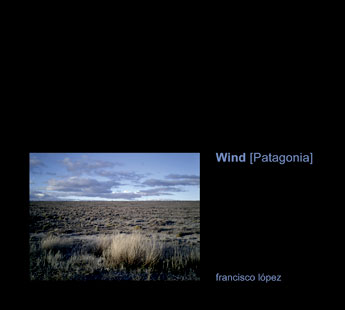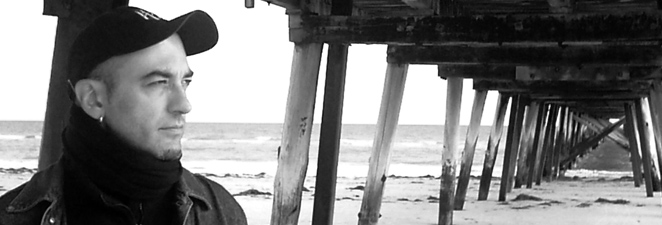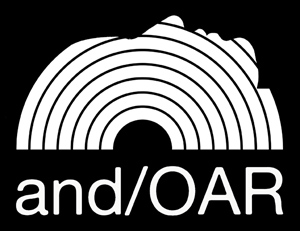Track List:
01. Wind [Patagonia] 56:55
and/OAR couldn't be more pleased to present the third part of Francisco
López's already classic "trilogy of the Americas" which started with La Selva,
and Buildings [New York] (both released by V2 Archief, Netherlands).
An immersion into the sonic matter from micro- and macro-environments
dominated by wind in Patagonia. A vast barren space shaped and inhabited
by the ever-changing forces of unmuted plants, rocks, sand, snow, and ice.
An irregular broad-band environment of relentless strength and richness.
And above all, a tour de force of profound listening.
López’s Patagonian winds have a ferocious beauty and immensity. Delicate
whispers combine with wild swarms and eddies undergirded by deep bass
punches. And all of this produced by an invisible force that endlessly sweeps
the surface of the globe. With this, we are no longer in the tidy world of human
music, but have entered the sublime domain of natural sound. (Christoph
Cox).
Packaged in a super gloss digipak with a 16 page, 4 color booklet.
Reviews
_________________________________________________________________________________
Signal To Noise (Spring 2008)
Storms and other such natural disasters stand as non-representative
vicissitudes par excellence. The lack of natural laws connecting the weather
here and the mysterious beyond out of which it appears sets in motion a
search for correlations and coincidences that brings no small amount of
pleasure. With Wind, sound artist Francisco Lopez forgoes any such attempt
to conjure the specter of the wind and reveal some of its secrets. Instead, he
uses contact microphones like tiny mirrors, positioned strategically, which
reflect some of the many voices of the wind and their ability to arrest and
negate a sense of time and reality. The sounds are identifiable enough, but
torn from their relational frameworks and real-life implications, they become
something other, something uncanny, or, better, they enter upon another -
perhaps pure - state in which their internal properties are explored. Such
was the goal of Lopez, as outlined in the brief linear notes accompanying the
work, and in this he is wholly successful. From rippling surges to
sub-aquatic whirrs and calm pools broken gently by incidental creaks and
croaks, Wind touches a world whose physical and emotional heft is
unexpectedly strong and resilient. (Max Schaefer)
Tokafi (March 2008)
ALBUM OF THE MONTH:
A dramaturgical and utterly personal presence: A 57-minute piece composed
of nothing but wind-related field recordings. There is no such thing as “pure
sound”, of course. At least not in the sense that it could ever be entirely
without reference. And yet, on Wind [Patagonia], Francisco Lopez returns to a
place, where these references loose their meaning and dissolve as the
music unfolds. This ideal goes hand in hand with a listening process, “which
doesn’t deny what is outside the sounds”, according to Lopez, “but explores
and affirms all what is inside them.” The result of this quest has turned out
mind shattering, but how can one talk or write about an album which just
wants to be heard and nothing else?
No substitute for listening, and/OAR have thankfully ignored the possible
dilemmas between form and philosophy and placed the existentially pitch
black CD inside a luxurious super gloss Digipack, accompanied by a 16-
page booklet whose colour photography pays tribute to the sparse planes
and raw romance of Patagonia. Inspired by the music, Christoph Cox
delivers an intoxicating, smart and informative essay in the booklet, which
gives hope for the reinvigoration of the long-lost art of liner notes. Cox places
Wind [Patagonia] in the context of the trilogy which opened with “La Selva”
and continued on the 2001-effort “Buildings [New York]”, he draws elegant
parallels with Burke and Kant and observes the particular importance of the
microphone (a “sine qua non” of field recordings as he puts it) in this
instance, because wind can only be heard when it touches objects or
surface areas.
Neither Cox’s article, nor the artwork, however exquisite as they may be, can
substitute or supplement the listening experience. The same, I fear, goes for
a descriptive approach to introducing this record. Lopez has combined
various site-specific, wind-related field recordings into a single, 57-minute
piece. Other than choosing the right places and the equipment to record
them with, the entire material has remained unprocessed with only
sequencing, segueing and the length of each segment falling into the
responsibility of the composer. These parameters are, however, enough to
unfold an overwhelming presence.
As eruptive as a classical symphony Lopez's recordings range from gale
storms to howling and hollering winds, from scarily eruptive thrusts to
meditative states of rest, from the harsh and loud opening to the gradually
dying-down whisper of the finale. It is the dramaturgical and utterly personal
presence which he establishes over the course of the piece, combined with
the immediacy of his field tracks, which shake the listener up like a classical
symphony.
The symphony is not a bad metaphor in this respect, because it, too, has the
potential to transcend the plentiful concrete associations evoked by the
orchestra. Wind [Patagonia] conjures up images of Haiku-like precision and
intensity, rising from the inside of these sounds in moments of absolute
clarity. Asking where they came from would only lead to their destruction.
All of this is nothing but a faint representation of what really happens here. At
times, the album really comes close to attaining the status of pure sound,
and when it does, the listener suddenly finds himself alone with nothing to
fall back to but himself. A lot of questions are raised in this context, but their
discussion is barely a public one. “My recommendation”, Francisco Lopez
says, “is – having knowledge of the existence of referential levels – to keep
them closed.” He’s right. It’s better that way. (Tobias Fischer)
Earlabs (February 2008)
This wind-beaten region located on the far southern reaches of South
America known as Patagonia has been called “the land of the living wind", a
place of surreal images where birds can be seen to fly backwards and trees
grow sideways.
Wind [Patagonia] is the third in series of pure environmental sound
recordings. The CD is accompanied by a beautiful, sixteen page booklet
containing images, introductory text by Francisco López (FL), and an
extended essay by Christoph Cox (CC). It’s purpose is to give: “An appraisal
of the richness and essential qualities of the original sonic material” (FL).
The first two CDs in the series featured a collection of various sounds from
two contrasting environments. The first being a Costa Rican rain forest and
the second, various buildings in New York City. Wind [Patagonia] is different
in the sense that it a focuses on just one fundamental, transcendent sound
source - “the sonic power of air gusts and currents“ (CC) - wind.
Wind [Patagonia] can be appreciated on two levels. On the one hand, it’s an
unadulterated (but not unbiased) audio record of a specific weather
phenomena occurring in a particular locality. On the other hand, in an
abstract sense, it’s instance of wideband noise that can be uniquely
interpreted by each listener, shaded with his/her own experiences and
preconceptions - independent of the actual sounds that were recorded and
where they were recorded. So, in the concrete sense, one listener might hear
strong gusts of wind in the forefront of the initial few minutes while another
listener, assuming the abstract vantage point, might hear powerful bursts of
wideband noise. The strong gusts and swells of wind that are evident in the
forefront of the initial few minutes might also be interpreted as powerful,
swirling bursts of wideband noise while gentle, steady streams of air
currents become segments of calm drones.
In the liner notes, Christoph Cox argues that in listening to this recording of
Patagonian winds “we are no longer in the tidy world of human music, but
have entered the sublime domain of natural sound.” The pleasurable tones
and structure of man-made music aren’t present here. The winds of
Patagonia are an instance of raw, naturally occurring noise which crosses
over into the realm of those things that we humans regard as immense or
awe-inspiring or magnificent such as violent storms, the depths of the
oceans, and mountains. Things that we not only find beautiful but also that
bring about a bit of apprehension and fearful respect. (Larry Johnson)
Classical-Drone Blog (January 2008)
One of the most interesting releases from 2007 was by the peripatetic sound
artist Francisco López, entitled Wind [Patagonia]. It is the third in an
occasional series of extended works constructed from relatively
unprocessed field recordings from various locations in the western
hemisphere. The label description refers to the three releases as the "trilogy
of the Americas," but it is not only the sound origins that create a
commonality between the works. Each one has a similar cover design and
contains an extensive essay on how the work was created, along with the
same cautionary warning in all three releases, providing the listener with
information about "the background philosophy behind the work and about its
specific spatial-temporal 'reality,'" but urging him or her not to access them.
All this is very much in keeping with López's long term vision of 'absolute'
music. In various essays and interviews, he has situated himself with
reference to the work of musique concrète theorist Pierre Schaeffer, who
used sound objects without reference to their origins in the 'real' world.
López often blindfolds the audience at his concerts to de-emphasize the
sounds' relationship to the performer.
López has been at the forefront of sound art for nearly twenty-five years. He
originally trained as a biologist, spending considerable time in the Costa
Rican rain forest La Selva where the first of the three recordings was made.
La Selva is an amazing recording, bringing the rain forest to life through
close-miking magic. At several points, the listener can hear insects landing
on the microphone and taking off again, along with all of the other richness
present in the ecosystem. The second recording was urban: Buildings [New
York] captured the sounds of the city's infrastructure, including the World
Trade Center. Both albums portrayed a detailed sonic environment,
demonstrating the rhythmic and textural possibilities for a musical
interpretation.
Although Wind [Patagonia] shares several aspects with the earlier releases,
it seems to require a perceptual shift that is unique. It isn't simply that López
has moved his focus from the closed spaces of the rain forest and
sub-basements to the South American plains. One can hear various creaks
and squeaks, but the overwhelming sound source on the album is,
unsurprisingly, wind. Movement of air through empty space. The sound of
something invisible, something that's not really there. A Google search for
wind noise produces results that tell how to minimize and eliminate it. López
turns the act of listening on its head by calling attention to the invisible, the
ignored, the unseen. Even with this obscured sound palette, López has
created a work as varied, as detailed and as rich as the other releases in the
series. The great sweeps of white noise from the wind are complemented by
tiny sounds from the rest of the environment, rewarding the listener who has
successfully transferred the background to the foreground.
López is a prolific sound artist, with nearly fifty releases on CD alone. With
his focus on sound objects, it's not always possible to identify his sound
sources, but he casts a much wider net than field recordings. Nevertheless,
these three albums are among his best and most accessible. Wind
[Patagonia] is released on and/OAR, a small label specializing in field
recordings, and is available directly from the label as well as from the usual
gang of distribution suspects. (Caleb Deupree)
Plan B (January 2008)
During a particularly blustery English winter weekend, listening to the third
and final instalment of Francisco López's “Trilogy of the Americas” series
may seem a tad redundant. But like Olafur Eliasson's installation “The
Weather Project”, with its representations of the sun and sky, López's work
compels the listener to meditate more deeply on the everyday natural
phenomena that we either take for granted or occasionally even resent.
These field recordings of the air gusts and currents that patrolled the
Argentinian Patagonia during the Austral winters of 2000 and 2003 are
simple in their presentation; unadorned and elegant. Delicate whispers mix
with ferocious eddying blasts, inhuman intensity juxtaposed with sublime
beauty; these delightful expositions of “the invisible force that endlessly
sweeps the surface of the globe”, when taken in conjunction with the
accompanying photographs and Christoph Cox's fine liner notes, constitute
both an absorbing documentary and a stunning aesthetic object.
(Spencer Grady)
Touching Extremes (January 2008)
This is the last CD that I listened to in 2007, right in the middle of the final
December evening - so much for firecrackers and champagne - and the
opener of the subsequent morning. While I’m writing, as it often happens,
the windows are open and an icy winter breeze in a glowing sunny afternoon
is being heard, the effect on the fallen leaves that of an irregular rustle
interrupting the first day of January’s somnolent reprise of activities. From
here, this is seen as the completion of one among the innumerable cycles of
which our existence is full. In this same frame, Francisco Lopez’s recordings
of winds from the Argentine regions of Patagonia (Chubut, Santa Cruz and
Tierra del Fuego) finalizes the triptych started in 1998 with “La Selva” and
continued with “Buildings [New York]” in 2001. As he explains in the liners,
the author was (is) interested in “an extreme phenomenological immersion
led by anti-rationality and anti-purposefulness” in a “world devoid of human
presence”.
Lopez, a trained entomologist and accomplished deep listener of this planet’
s many voices, is also among the very few who have an actual chance to
experiment with the above described conditions, his recordings
documenting situations where nature and self-consciousness become parts
of a whole set of drastic states of mere being that only the fittest can endure.
In a strictly “musical” sense, three basic kinds of wind are captured in this
album: furiously ripping discharges that seem to destroy the microphone’s
capsule, distantly roaring whooshes whose voice is akin to hearing a
faraway jet, progressively calmer settings that close the show reducing the
level of perception down to a typical “Lopez silence”. It’s the depth of the
implications that transforms a potentially normal document of natural
sounds into a galvanizing, reinvigorating event. The Spanish soundscaper
needs no additional words to highlight an already recognized mastery in this
game. (Massimo Ricci)
Vital Weekly (November 2007)
Many of the works by Señor Lopez are sparsely packaged: his name, untitled
number so and so and a label name. The vast majority of his work doesn't
go beyond that low level of information. For reasons I am not entirely sure of
(or rather not at all), some works are packed with text: 'La Selva', 'Buildings
[New York]' and this new one Wind [Patagonia] too (the link might be they
are all recorded in America). So we learn that this piece of fifty-six minutes is
a 'non-processed, not mixed environmental sound matter from a certain
'reality'' and in this case the reality is the wind the empty spaces of
Patagonia, in the southern part of Argentina. During the 'austral winters' of
2000 and 2003, Lopez recorded a whole bunch of wind. The empty space,
usually referred as a quiet one in the world of musical reviews (certainly by
Vital Weekly) is of course a misconception. Silence as such doesn't exist and
the wind can be harsh player. The wind blows here heavily in the microphone
- various types are used - and the membrane shakes along. It's not a straight
forward, almost one hour piece of wind blowing. In his piece he uses various
segments of wind sound, both the 'quiet' and the 'loud' and thus depicts a
beautifully cruel world. As a biker I learned to dislike the wind, as much as I
like it; it depends on which way you are going. This new work fits along very,
very well along the two previous mentioned releases and for those who care
to know: this isn't the all out silent Lopez, as it's audible through the end,
although the sound is in a long fade out. A great conclusion to a great trilogy.
(Frans De Waard)
Wall Of Sound (October 2007)
Do the winds of Argentina sound any different than the winds of Tukwila?
Probably not. Although there is a lot of wind here to hear. Close to an hour in
fact. And it's a strong wind. So part of the power of this CD lies in it's
evocation of nature's power. It's palpable. Turn it up and it's terrifying. But
beyond that, what's most beautiful here is when you can hear the wind as
music. It takes an open mind and it's admittedly challenging, but if you can
hear the rhythms of the shifting winds as you would those of a jazz drummer
and hear the sound of the wind as you would the tones of a microtonal
composer, you're on your way. It's one of John Cage's basic lessons and it's
a good one. Master it and you'll hear music everywhere. (Michael Ohlenroth)












Artist: Francisco López
Title: Wind [Patagonia]
Catalog Number: and/27
Release Year: 2007
Format: CD
Status: sold out





